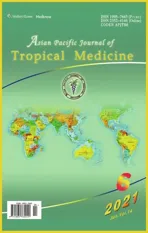Severe eosinophilia associated with hydroxychloroquine use in a patient with COVID-19
2021-07-05ResatOzarasAltanBayarNiiarAliogluSemihaBaysoy
Resat Ozaras, Altan Bayar, Niiar Alioglu, Semiha Baysoy
1Infectious Diseases Department, Medilife Hospital, TR-34524 Beylikdüzü, Istanbul, Turkey
2Intensive Care Unit, Medilife Hospital, TR-34200 Bagcilar, Istanbul, Turkey
3Internal Medicine Department, Medilife Hospital, TR-34200 Bagcilar, Istanbul, Turkey
4Pediatrics Department, Medilife Hospital, TR-34200 Bagcilar, Istanbul, Turkey
Hydroxychloroquine, a 4-aminoquinoline derivative, is indicated in systemic lupus erythematosus, rheumatoid arthritis and other inflammatory rheumatic diseases[1]. Its main adverse drug reactions are retinopathy during long-term exposure with high doses,cardiac damage with arrhythmias, potentially severe skin damage,neuromyopathy, and hematological damage such as bone marrow aplasia and agranulocytosis[2]. Eosinophilia, although very rare, is a known side effect of this drug[3]. We came across a case of severe eosinophilia without skin manifestations during the treatment of COVID-19 with hydroxychloroquine.
A 50-year-old female with fever, myalgia, cough, and shortness of breath for 4 days was admitted on March 28, 2020. She had asthma and diabetes for 10 years and ischemic heart disease for 2 years. On examination, vital signs were remarkable for a temperature of 38.5 ℃,there was note of hyperemia in the oropharynx and lungs were clear on auscultation. The initial laboratory values showed: leukocytes 7.3×10/L, lymphocytes 0.9×10/L, eosinophils 0.09×10/L (normal range: 0.02×10/L to 0.5×10/L), C-reactive protein (CRP)9 mg/L (normal: 0-5 mg/L), ALT 19 U/L, AST 18 U/L, ferritin 102 ng/mL (12-150 ng/mL), and creatinine 0.6 mg/dL. She was diagnosed with COVID-19 by PCR study of nasopharyngeal swap specimen and thorax CT revealed bilateral ground glass opacities. She was hospitalized in an isolation room and was given hydroxychloroquine (first day 400 mg bid, then 200 mg bid). Following the second day (fourth dose) of hydroxychloroquine, eosinophil counts increased to 6.1×10/L (Figure 1). During hospitalization, he was complicated with decline in respiratory function and persistence of fever. Favipiravir (first day 1 600 mg bid, then 600 mg bid 4 days)azithromycin (500 mg/day), bronchodilatory treatment, oxygen and paracetamol were added. Tocilizumab (400 mg bid) was given considering high fever, high levels of CRP and ferritin as well as accelerated erythrocyte sedimentation rate of 110 mm/hour (normal range: 0-30 mm/hour). Eosinophil counts increased significantly after initiation of hydroxychloroquine and therefor, this drug was thought responsible for eosinophilia. However, since she was severely ill, the drug could not be discontinued.
After 22 days of therapy, she responded well and hydroxychloroquine treatment was discontinued. Eosinophil counts continued to increase reaching up to 19.3×10/L and liver transaminases increased (ALT 149 U/L and AST 67 U/L). No skin rash was observed. Stool examination revealed no parasites.Methylprednisolone 0.5 mg/kg/day was given for 3 days and eosinophil counts decreased to normal rapidly and levels of liver transaminases decreased. She was discharged after a symptomfree follow-up period of 3 days. At follow-up visit 14 days after discharge, she was doing well with normal blood count.The most frequent cutaneous side effects of hydroxychloroquine are skin rash and pigmentation[2,4]. Clinically important dermatological manifestations including drug rash with eosinophilia and systemic symptoms syndrome, acute generalized exanthematous pustulosis, Stevens-Johnson syndrome, toxic epidermal necrolysis, and Sweet’s syndrome secondary to administration of hydroxychloroquine have been reported[4,5]. Eosinophilia has been described generally as a part of drug rash with eosinophilia and systemic symptoms syndrome. However we suggest that with or without skin findings, hydroxychloroquine use may be associated with eosinophilia and under the conditions of COVID-19 pandemic,clinicians should be aware of this side effect of hydroxychloroquine.

Figure 1. Time table showing eosinophil counts and treatment of the patient (T: tocilizumab; M: Methylprednisolone). Hydroxychloroquine: started on 28th March 2020, discontinued on 19th April 2020; Azithromycin: started on 10th April 2020, discontinued on 19th April 2020; Favipiravir: started on 10th April 2020, discontinued on 15th April 2020; Tocilizumab: started on 15th April 2020, discontinued on 16th April 2020 (Explanation: 2 doses given 24 hours apart, first was given on 15th April 2020 evening time and second dose was given on 16th April 2020 evening time); Methylprednisolone: started on 4th May 2020, discontinued on 7th April 2020.
Conflict of interest statement
We declare that we have no conflict of interest.
Authors' contributions
All authors participated the concept and design, acquisition of data,analysis and interpretation of data, and drafting of the manuscript.AB and NA followed the patient in isolation unit. SB is responsible for critical revision of the manuscript for important intellectual content.
杂志排行
Asian Pacific Journal of Tropical Medicine的其它文章
- Expert consensus on prevention and cardiopulmonary resuscitation for cardiac arrest in COVID-19
- Crimean-Congo hemorrhagic fever from the immunopathogenesis, clinical, diagnostic,and therapeutic perspective: A scoping review
- Ivermectin as an adjunct treatment for hospitalized adult COVID-19 patients: A randomized multi-center clinical trial
- A nomogram for predicting acute respiratory distress syndrome in COVID-19 patients
- Disseminated cutaneous leishmaniasis due to Leishmania (Leishmania) amazonensis in human immunodeficiency virus (HIV)-infected patients: A report of two cases
